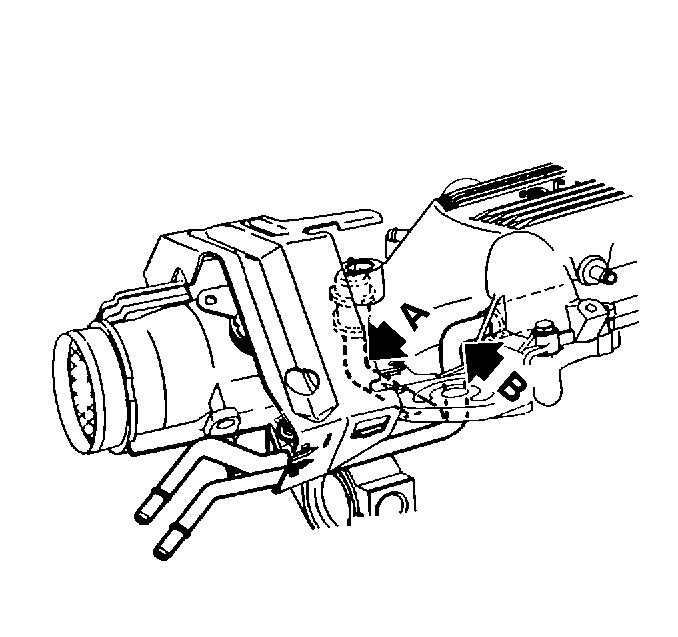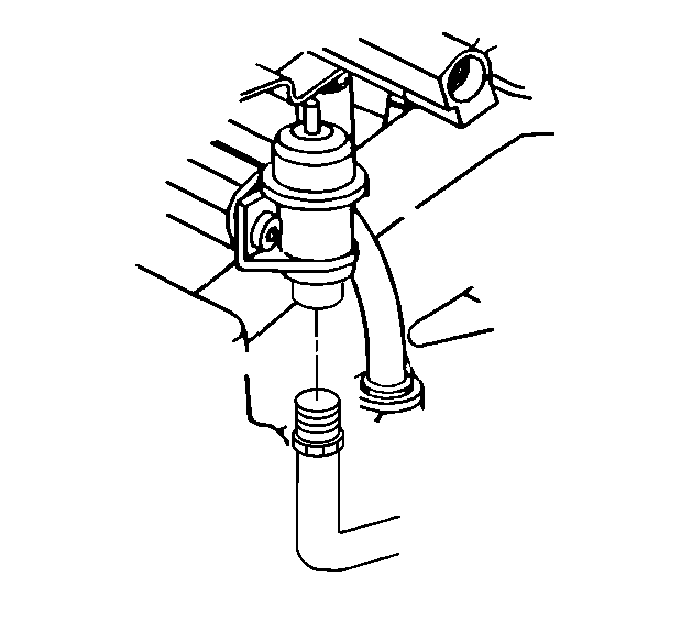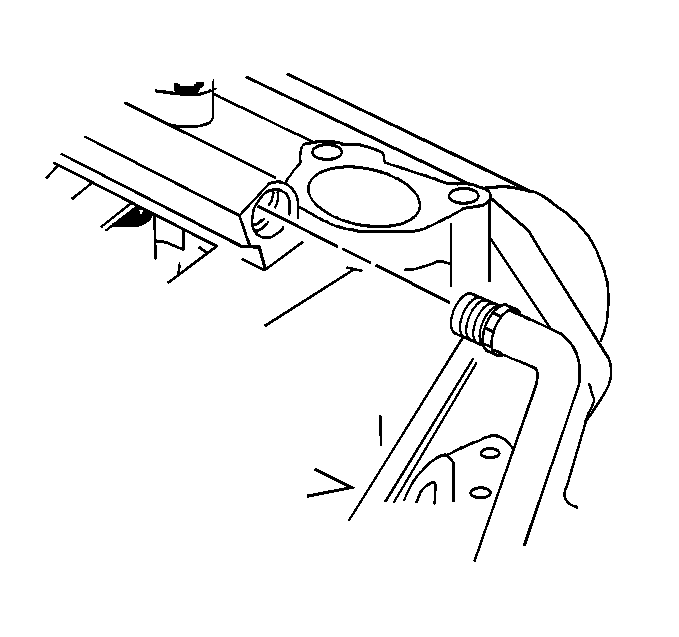Fuel Hose and Pipes Engine Compartment
Removal Procedure
Tools Required
J 37088-A tool set, Fuel Pipe Quick-Connect Separator.
Notice: Do not attempt to repair the engine fuel feed pipe or the engine fuel return pipe. Replace a damaged engine fuel feed pipe or the engine fuel return pipe.
- Relieve the fuel system fuel pressure. Refer to Fuel Pressure Relief
- Clean all engine fuel pipe connections.
- Clean areas surrounding the engine fuel pipe connections.
- Before disconnecting the engine fuel pipe connections to avoid possible contamination of the fuel system.
- Remove the quick-connect fittings in the engine compartment. Refer to Servicing Quick Connect Fittings
- Plug the chassis fuel feed pipe and the chassis fuel return pipe as required.
- Remove the upper intake manifold assembly. Upper Intake Manifold .
- Remove the engine fuel return pipe from the fuel pressure regulator. Discard the O-ring.
- Remove the engine fuel feed pipe from the fuel rail. Discard the O-ring.



Installation Procedure
- Lubricate the new O-ring with clean engine oil, then connect the O-ring and the engine fuel return pipe to the fuel pressure regulator.
- Lubricate the new O-ring with clean engine oil, then connect the O-ring and the engine fuel feed pipe to the fuel rail.
- Install the upper intake manifold assembly. Refer to Upper Intake Manifold .
- Install the quick-connect fittings in the engine compartment. Refer to Upper Intake Manifold .
- Tighten the fuel tank filler pipe cap.
- Install the negative battery cable.


Tighten
Tighten the engine fuel pipe fittings to 17 N·m(13
lb ft).
Notice: Use the correct fastener in the correct location. Replacement fasteners must be the correct part number for that application. Fasteners requiring replacement or fasteners requiring the use of thread locking compound or sealant are identified in the service procedure. Do not use paints, lubricants, or corrosion inhibitors on fasteners or fastener joint surfaces unless specified. These coatings affect fastener torque and joint clamping force and may damage the fastener. Use the correct tightening sequence and specifications when installing fasteners in order to avoid damage to parts and systems.

Fuel Hose and Pipes Engine to Fuel Sender
Removal Procedure
- Relieve fuel system pressure. Refer to Fuel Pressure Relief .
- Remove the quick-connect fittings at engine compartment fuel feed and return connecting lines. Refer to Servicing Quick Connect Fittings .
- Plug fuel lines.
- Raise vehicle.
- Remove the quick-connect fittings at fuel sender and nylon fuel feed and return connecting lines. Refer to Servicing Quick Connect Fittings .
- Plug fuel lines to prevent leakage.
- Remove the fuel pipe mounting hardware from pipes.
- Remove the fuel pipes to be serviced.
Notice: If necessary, remove rust or burrs from the fuel pipes with an emery cloth. Use a radial motion with the fuel pipe end in order to prevent damage to the O-ring sealing surface. Use a clean shop towel in order to wipe off the male tube ends. Inspect all the connections for dirt and burrs. Clean or replace the components and assemblies as required.
| • | Using a clean shop towel, wipe off male tube ends. |
| • | Inspect all connectors for dirt and burrs. Clean or replace components/assemblies as required. |
| • | In the repairable areas, cut a piece of fuel hose 100 mm (4 in) longer than portion of the line removed. If more than a 152 mm (6 in) length of pipe is removed, use a combination of steel pipe and hose so that hose lengths will not be more than 254 mm (10 in), including hose overlap on fuel line. |
Installation Procedure
- Position fuel pipe or line in body clips.
- Install the fuel pipe and hose hardware.
- Remove caps on lines.
- Install the quick-connect fittings on fuel lines. Refer to Servicing Quick Connect Fittings .
- Lower vehicle.
- Remove caps covering fuel lines if required.
- Install the engine compartment fuel line quick-connect fittings. Refer to Servicing Quick Connect Fittings .
- Install the fuel filler cap.
- Install the negative battery cable.
- Inspect for leaks.
| 10.1. | Turn ignition to ON position for 2 seconds. |
| 10.2. | Turn to OFF for 10 seconds. |
| 10.3. | Again turn the ignition to the ON position. |
| 10.4. | Check for fuel leaks. |
Fuel Hose and Pipes EVAP Pipes
Removal Procedure
Caution: In order to Reduce the Risk of Fire and Personal Injury:
• If nylon fuel pipes are nicked, scratched or damaged during installation,
Do Not attempt to repair the sections of the nylon fuel pipes. Replace them. • When installing new fuel pipes, Do Not hammer directly on the
fuel harness body clips as it may damage the nylon pipes resulting in a possible
fuel leak. • Always cover nylon vapor pipes with a wet towel before using a
torch near them. Also, never expose the vehicle to temperatures higher than
115°C (239°F) for more than one hour, or more than 90°C (194°F)
for any extended period. • Before connecting fuel pipe fittings, always apply a few drops
of clean engine oil to the male pipe ends. This will ensure proper reconnection
and prevent a possible fuel leak. (During normal operation, the O-rings located
in the female connector will swell and may prevent proper reconnection if
not lubricated.)
Notice: Replace the EVAP pipes and hoses with the original equipment or parts that meet the GM specifications for those parts. The replacement EVAP pipe must have the same type of fittings as the original pipe in order to ensure the integrity of the connection. When replacing EVAP hoses, use only reinforced fuel-resistant hose identified with the word Fluoroelastomer or GM 6163-M on the hose. The inside hose diameter must match the outside pipe diameter. Do not use rubber hose within 100 mm (4 in) of any part of the exhaust system or within 254 mm (10 in) of the catalytic converter.
- Remove the retaining hardware and clamp as necessary.
- Note location and position for future reference.
- Remove the pipe or hose.
Important: Inspect hoses and vapor lines for cuts, swelling, cracks, kinks and distortion.
Installation Procedure
- Install the vapor line or hose.
- Install the retaining hardware and clamps.
Important: Follow the same routing as original pipe or hose.
